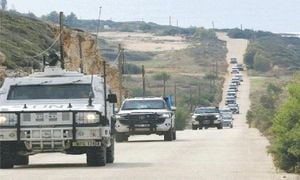The streets of Kathmandu and other Nepali cities have rarely seen such a surge of youthful energy, frustration, and hope as they did in September 2025. In the days since, Nepal’s political landscape has been transformed by the Generation Z (Gen Z) movement—a sweeping, digitally-coordinated uprising that has forced the nation to reckon with deep-seated corruption, a lack of representation, and a growing generational divide.
On November 11, 2025, a coalition of Gen Z leaders finalized a nine-point draft agreement and submitted it to Prime Minister Sushila Karki’s advisors. According to The Kathmandu Post, this draft seeks nothing less than a fundamental overhaul of Nepal’s democratic processes and governance. At its core, the document demands that the government recognize the Gen Z uprising of September 8-9 as a legitimate political movement, born from widespread dissatisfaction with the status quo. The draft calls for justice for the seventy-six people killed during the protests—nineteen of whom were unarmed demonstrators slain on the movement’s first day—and insists that those lost be declared martyrs, with immediate relief and free healthcare for their families and the injured.
But how did Nepal reach this point? As detailed by Pramod Jaiswal and Bibek Dhoj Thapa in Asia-Pacific Leadership Network’s analysis, the seeds of revolt were sown through digital conversations about the privileges enjoyed by politicians and their children—dubbed #NepoBabies. This online chatter quickly snowballed into a nationwide movement, fueled by years of frustration with entrenched political elites, corruption, and poor governance. When the government responded by banning 26 social media platforms, young activists simply migrated to alternate channels like Discord, led by a group calling itself “Youth Against Corruption.”
Thousands of young Nepalis soon filled the streets. The government’s response was harsh and immediate: security forces fired live ammunition, including above the waist, killing over 20 people on the first day—some of them schoolchildren. The violence only intensified public outrage. By September 9, the protests had escalated into chaos, with mobs attacking public infrastructure, setting government buildings and media houses ablaze, and targeting the residences of senior political leaders. Iconic institutions such as Parliament, the judiciary, and executive offices became flashpoints, underscoring the depth of public anger.
The Gen Z movement drew support from civil society, the media, intellectuals, and even celebrities, uniting diverse groups under the banner of anti-corruption and political reform. The movement’s demands soon crystallized into a political force that toppled the KP Oli-led coalition government. On September 12, an interim government led by former Chief Justice Sushila Karki was formed, backed by Gen Z activists and tasked with holding snap elections set for March 5, 2026.
The nine-point draft agreement presented to the government is sweeping in scope. It urges the formation of an independent commission—one that includes Gen Z representatives—to investigate the events of September, recommend prosecution of those responsible for state violence, and differentiate between protesters and those involved in organized criminal acts. The draft also calls for institutional reforms to prevent future abuses by Nepal’s security forces, as well as prompt and fair investigations into corruption, abuse of authority, and unexplained wealth among political leaders and officials.
Transparency and accountability are central themes. The draft demands that the government facilitate voter registration for eligible Gen Z members and other citizens, including Nepalis living abroad, and amend election laws to ensure free, fair, and peaceful elections. It also proposes a high-level independent committee to review and recommend amendments to Nepal’s constitution—aiming to guarantee national sovereignty, democracy, equality, inclusion, and robust anti-corruption measures.
Inclusivity is another cornerstone. The Gen Z leaders stress that all government bodies, including the Council of Ministers and any new institutions created under the accord, must reflect the full diversity of Nepali society: women, Dalits, indigenous groups, Madhesis, Tharus, Muslims, marginalized communities, people with disabilities, LGBTQ+ persons, farmers, workers, and the economically disadvantaged. An expert advisory group with Gen Z and youth representation is also recommended to ensure that the interests of younger generations are not sidelined.
Digital freedoms are not forgotten. The draft explicitly opposes any illegal regulation, ban, or censorship of internet and digital communications, and calls for legal, physical, and technical safeguards to protect both freedom of expression and personal privacy. The government is advised to prevent illegal surveillance or misuse of citizens’ digital data, a concern that resonates deeply with digitally-savvy Gen Z activists.
The Gen Z movement’s anti-corruption drive has already begun to yield tangible results. On November 11, the Gen Z Movement Nepal publicly demanded the immediate dismissal of Energy Minister Kulman Ghising and the registration of a corruption case at the Commission for the Investigation of Abuse of Authority (CIAA), following revelations about a controversial power purchase agreement (PPA) with India. As reported by Republica, the movement alleges that the deal—signed between the Nepal Electricity Authority (NEA) and India’s PTC India on October 13—resulted in a financial loss of Rs 430 million for Nepal. The movement has called for an investigation under the Money Laundering Prevention Act against both Minister Ghising and NEA Managing Director Manoj Silwal, demanding their suspension pending the outcome and urging the Electricity Regulatory Commission to make all such agreements public for the sake of transparency.
These developments have not gone unnoticed by Nepal’s political establishment or the wider region. The scale and speed of the protests have drawn inevitable comparisons to youth-led regime changes in neighboring South Asian countries—Sri Lanka’s 2022 mass protests and Bangladesh’s student uprising in 2024, for instance. Speculation about foreign involvement has swirled, with some pointing to organizations with Western connections or to India’s right-wing groups. Yet, as Jaiswal and Thapa note, the Gen Z uprising in Nepal was overwhelmingly homegrown—a spontaneous revolt against systemic corruption, elite capture, and the betrayal of democratic ideals.
Still, challenges abound. The interim government faces the daunting task of restoring law and order, conducting credible elections, and rebuilding public trust. The cabinet remains incomplete, hampered by internal divisions and competing youth factions. Security apparatuses have been weakened by the chaos—looted weapons and jailbreaks during the protests have left their mark. Meanwhile, entrenched political elites may try to portray anti-corruption measures as politically motivated or even boycott the elections, threatening the fragile progress made so far.
Yet, the message from Nepal’s Gen Z movement is unmistakable: a new generation, armed with digital connectivity and global awareness, will no longer tolerate corruption, nepotism, or the failures of the past. Their uprising has already transformed Nepal’s political discourse, exposed deep-rooted corruption, and revived civic engagement. Whether this energy can be channeled into lasting institutional reform remains to be seen—but for now, Nepal stands at a crossroads, with its youth demanding a future built on transparency, justice, and genuine representation.




